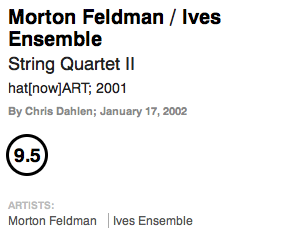
Het invloedrijke Amerikaanse muziekmagazine Pitchfork gaf onze opname van Morton Feldmans String Quartet (II) een ongelooflijke 9.5!
“As it happens, this is a terrific performance of a fascinating work that rewards all the time you can give it. (…) Feldman is essential listening.”
Lees hier de recensie:
“In his later years, American composer Morton Feldman wrote long compositions. Really, really long compositions. Piano and String Quartet and For Bunita Marcus each fill an eighty minute CD; For Christian Wolff runs around three hours; For Philip Guston clocks in at over four. Each piece is monolithic, with no interruptions and no movements or other divisions.
The mother of them all, however, is his until-now unrecorded String Quartet II. Hat Hut’s hat[now]ART imprint just released the first recording, performed by members of the Ives Ensemble for a duration of almost five hours. First performed by the Kronos Quartet, the piece runs anywhere between four and (allegedly) six hours, with few rests and no interruptions. Kronos performed it live several times and never recorded it: they cancelled their scheduled final performance for health reasons. David Harrington, violinist and Kronos’ artistic director, said in an interview for the NEA: “The Second Quartet is physically so demanding… I think marathon runners must go through the same thing we do when we play The Second Quartet… you go in and out of feeling your body is going to break. Even right now when I’m thinking of The Second Quartet I have a shooting pain in my back.”
Feldman fans have been waiting for a recording of String Quartet II since Feldman wrote it eighteen years ago. Even if the Ives Ensemble blew it, this record would be a milestone. As it happens, this is a terrific performance of a fascinating work that rewards all the time you can give it.
Anyone who hasn’t heard a Feldman piece may wonder how the time passes. The short answer is that it doesn’t. One of Feldman’s agendas was to turn time into space: to make time feel not like a line, but like a landscape that the listener has dropped into. The pieces hardly begin and don’t seem to end. He uses only a few themes, but as he repeats a phrase or motif, he alters it by changing the time signature or the dynamics in subtle but discernable ways. Rather than repetitive, the simplest elements become engrossing. With that construction, the size of the works gives them mass. During For Philip Guston, a phrase may slowly repeat until it’s heavy and unmovable, like a boulder settling on the floor of the ocean. This superficially sounds like a “deep listening” exercise, but unlike ambient music, there’s no slack: Feldman’s excruciating detail and strict control make the works mentally engaging, refusing to allow a passive audience. It doesn’t become the background; it becomes the air you’re breathing.
Though it’s his longest, String Quartet II is one of Feldman’s most dynamic and aggressive works. The strings jump between themes, play occasional flurries of notes, and produce a more grinding and aggressive sound than on, say, the serene and austere Piano and String Quartet. In the first 2xBD hours the music ranges from barely audible to enraged. A set of themes is reworked and revisited; they’re so short that they seem more like gestures, until you’ve heard them so many times that they become melodies. Progress is only experienced measure by measure before the piece changes direction again. By the third disc it calms down: sections last longer and sound more subdued, and some of them are outright pretty. Feldman even throws in a brief pizzicato cello part that’s almost funky. The last disc doesn’t offer a sharp ending. There’s a slow trailing off that again suggests it’s not done; we’re just leaving it behind.
Having never heard the piece in concert, I can’t compare this debut recording to any other performance. The Ives Ensemble’s playing is just short of academic, but appropriate for this piece. Feldman specifies many tonal colors that the musicians go to pains to reproduce accurately and engagingly. And they don’t show the fatigue you might expect at the end— they’ve performed this in concert a few times, and may be “in shape,” but I’m also not sure how (or in how many pieces) they recorded it.
Hat[now]ART published String Quartet II in an edition of only 3,000 copies, which is like locking people out of museums (but which might meet demand). That’s unfortunate: Feldman is essential listening. New listeners might start with shorter works, like Kronos’ Piano and String Quartet or the New Albion edition of Rothko Chapel, but everyone should have a chance to confront this thing at least once.”
Bron: Pitchfork

